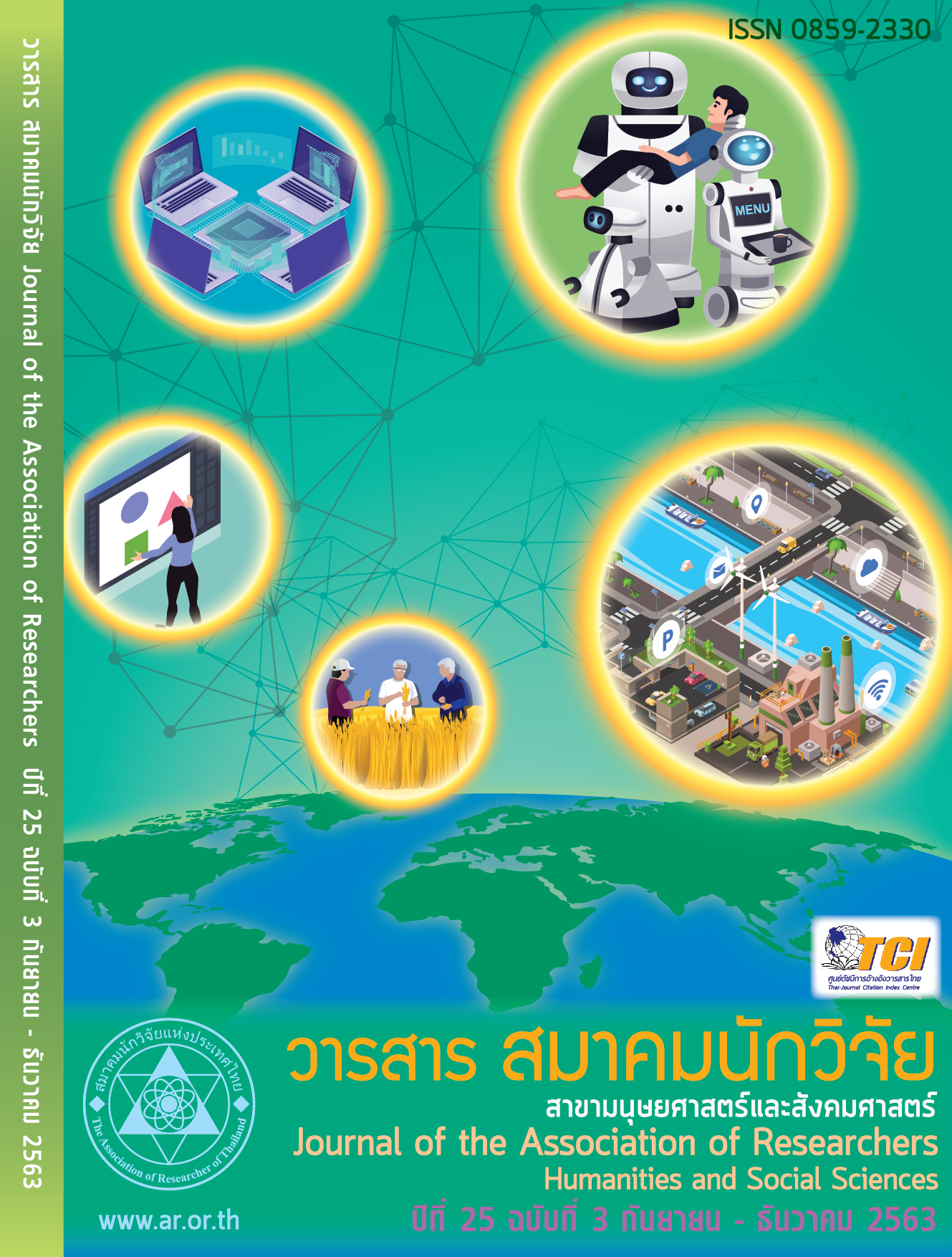Effect of User Characteristics and Internet Using Behavior on the Adoption of Internet Banking
Main Article Content
Abstract
Nowadays, Internet banking has grown considerably in Thailand. Especially, due to the spread of COVID-19, people try to avoid touching money. From previous studies of internet banking adoption, there are few studies in Thailand. Most of the studies do not include user characteristics and internet-related behaviors that may cause people to adopt internet banking. The data used in this study were from the survey in Thailand conducted by the Office of the National Broadcasting and Telecommunications Commission (NBTC). Logistic regression analysis showed that income, age, education, OTT (Over-the-Top) using experiences, using postpaid plans and extra payments for online entertainment or storage were the main factors influencing the adoption of internet banking. Policy implications are that banks should provide training about internet banking or mobile banking to customers and improve communication to the target customers to increase internet banking adoption.
Article Details
บทความที่ปรากฏในวารสารนี้ เป็นความรับผิดชอบของผู้เขียน ซึ่งสมาคมนักวิจัยไม่จำเป็นต้องเห็นด้วยเสมอไป การนำเสนอผลงานวิจัยและบทความในวารสารนี้ไปเผยแพร่สามารถกระทำได้ โดยระบุแหล่งอ้างอิงจาก "วารสารสมาคมนักวิจัย"
References
Bankole, F. O., Bankole, O., & Brown, I. (2011). Mobile Banking Adoption in Nigeria. 47. doi:10.1002/j.1681-4835.2011.tb00330.x
Clemes, M. D., Gan, C., & Du, J. (2012). The factors impacting customers' decisions to adopt Internet banking. Banks & bank systems(7, Iss. 3), 33-50.
Davis, F., Bagozzi, R., & Warshaw, P. (1989). User Acceptance of Computer Technology: A Comparison of Two Theoretical Models. Management Science, 35, 982-1003. doi:10.1287/mnsc.35.8.982
Devi Juwaheer, T., Pudaruth, S., & Ramdin, P. (2012). Factors influencing the adoption of internet banking: a case study of commercial banks in Mauritius. World Journal of Science, Technology and Sustainable Development, 9(3), 204-234. doi:10.1108/20425941211250552
Fall, F.-S., Ky, Y., & Birba, O. (2015). Analyzing the Mobile-Banking Adoption Process among Low-Income Populations: A Sequential Logit Model. 35(4), 2085-2103.
Gan, C., Clemes, M., Limsombunchai, V., & Weng, A. (2006). A logit analysis of electronic banking in New Zealand. International Journal of Bank Marketing, 24(6), 360-383. doi:10.1108/02652320610701717
Greene, W. H. (2003). Econometric analysis: Pearson Education India.
Hootsuite, & We Are Social. (2019). Global Digital 2019 reports. Retrieved from https://wearesocial.com/global-digital-report-2019
Hootsuite, & We Are Social. (2020). Digital 2020 Global Overview Report.
Jaruwachirathanakul, B., & Fink, D. (2005). Internet banking adoption strategies for a developing country: the case of Thailand. Internet Research, 15(3), 295-311. doi:10.1108/10662240510602708
Kim, B.-M., Widdows, R., & Yilmazer, T. (2005). The determinants of consumers’ adoption of Internet banking. Conference Series ; [Proceedings].
Laforet, S., & Li, X. (2005). Consumers’ attitudes toward online and mobile banking in China. International Journal of Bank Marketing, 23, 362-380. doi:10.1108/02652320510629250
Mbiti, I., & Weil, D. (2011). Mobile Banking: The Impact of M-Pesa in Kenya. doi:10.3386/w17129
Nasri, W., & Charfeddine, L. (2012). Factors affecting the adoption of Internet banking in Tunisia: An integration theory of acceptance model and theory of planned behavior. The Journal of High Technology Management Research, 23(1), 1-14. doi:https://doi.org/10.1016/j.hitech.2012.03.001
Riquelme, H., & Rios, R. (2010). The moderating effect of gender in the adoption of mobile banking. The International Journal of Bank Marketing, 28, 328-341. doi:10.1108/02652321011064872
Stavins, J. (2002). Effect of Consumer Characteristics on the Use of Payment Instruments. New England Economic Review· February.
Suoranta, M., & Mattila, M. (2004). Mobile banking and consumer behavior: New insights into the diffusion pattern. Journal of Financial Services Marketing, 8(4), 354-366. doi:10.1057/palgrave.fsm.4770132
Tan, M., & Teo, T. (2000). Factors Influencing the Adoption of Internet Banking. J. AIS, 1, 0. doi:10.1080/10864415.1998.11518312
ธนาคารแห่งประเทศไทย. Electronic Banking Service Type. สืบค้นจาก https://www.bot.or.th/Thai/Statistics/DataManagementSystem/TempClose/FI_FM1/MetadataLibrary/CL_Metadata/Documents/Electronic%20Banking%20Service%20Type.doc
ธนาคารแห่งประเทศไทย. ธูรกรรมการชาระเงินผ่านบริการ Mobile Banking และ Internet Banking. สืบค้นจาก https://www.bot.or.th/App/BTWS_STAT/statistics/BOTWEBSTAT.aspx?reportID=688&language=TH
ธนาคารทหารไทย. (2563). Cashless Society 5 ข้อดีที่จะตามมาเมื่อเราเข้าสู่สังคมไร้เงินสด. สืบค้นจาก https://www.tmbbank.com/balance-by-tmb/money/balance-cashless-society.html
ศูนย์วิจัยกสิกรไทย. (2563). กระแส Contactless Payment ดึง...ฐานลูกค้าใหม่สู่ Mobile Banking และ e-Wallet. สืบค้นจาก https://kasikornresearch.com/th/analysis/k-social-media/Pages/Contactless-Payment-FB-140920.aspx
Translated Thai References
Bank of Thailand. Electronic Banking Service Type. Retrieved from https://www.bot.or.th/Thai/Statistics/DataManagementSystem/TempClose/FI_FM1/MetadataLibrary/CL_Metadata/Documents/Electronic%20Banking%20Service%20Type.doc (in Thai)
Bank of Thailand. Financial Transaction via Mobile Banking and Internet Banking. Retrieved from: https://www.bot.or.th/App/BTWS_STAT/statistics/BOTWEBSTAT.aspx?reportID=688&
language=TH (in Thai)
Thai Military Bank. (2020). Cashless Society: 5 Advantages When We Become a Cashless Society. Retrieved from https://www.tmbbank.com/balance-by-tmb/money/balance-cashless-society.html (in Thai)
Kasikorn Research Center. (2020). Contactless Payment Trend Attracts New Consumers to Mobile Banking and e-Wallet. Retrieved from https://kasikornresearch.com/th/analysis/k-social-media/Pages/Contactless-Payment-FB-140920.aspx (in Thai)


